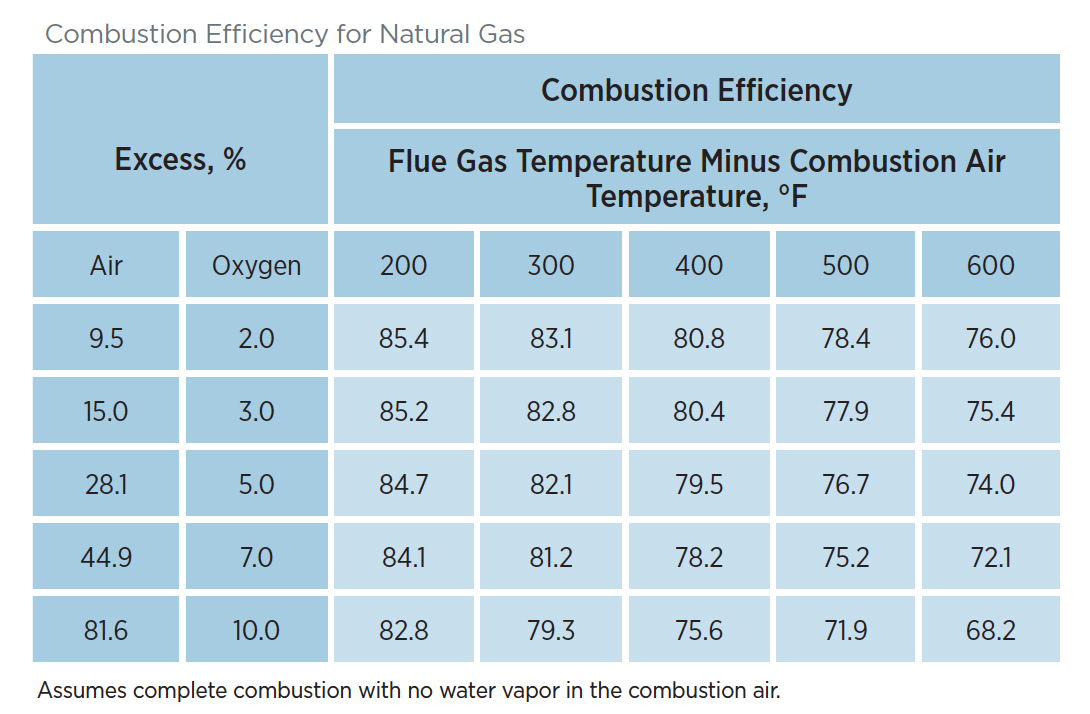 On well-designed natural gas-fired systems, an excess air level of 10% is attainable. An often-stated rule of thumb is that boiler efficiency can be increased by 1% for each 15% reduction in excess air or 40°F reduction in stack gas temperature.
Example
A boiler operates for 8,000 hours per year and annually consumes 500,000 million Btu (MMBtu) of natural gas while producing 45,000 lb/hour of 150-psig steam. Stack gas measurements indicate an excess air level of 44.9% with a flue gas minus combustion air temperature of 400°F. From the table, the boiler combustion efficiency is 78.2% (E1). Tuning the boiler reduces the excess air to 9.5% with a flue gas minus combustion air temperature of 300°F. The boiler combustion efficiency increases to 83.1% (E2). Assuming a fuel cost of $8.00/MMBtu, the annual savings are:
Annual Savings = Fuel Consumption x (1–E1/E2) x Fuel Cost
= 29,482 MMBtu/yr x $8.00/MMBtu
= $235,856
Flue Gas Analyzers
The percentage of oxygen in the flue gas can be measured by inexpensive gas-absorbing test kits. More expensive (ranging in cost from $500 to $1,000) hand-held, computer-based analyzers display percent oxygen, stack gas temperature, and boiler efficiency. They are a recommended investment for any boiler system with annual fuel costs exceeding $50,000.
Oxygen Trim Systems
When fuel composition is highly variable (such as refinery gas, hog fuel, or multi-fuel boilers), or where steam flows are highly variable, an online oxygen analyzer should be considered. The oxygen “trim” system provides feedback to the burner controls to automatically minimize excess combustion air and optimize the air-to-fuel ratio.
Click to download the complete U.S. Department of Energy’s Tip Sheet then contact Campbell-Sevey to see how we can help you improve your boiler’s combustion efficiency.
This tip is provided by the U.S. Department of Energy – Energy Efficiency and Renewable Energy and originally published by the Industrial Energy Extension Service of Georgia Tech.
On well-designed natural gas-fired systems, an excess air level of 10% is attainable. An often-stated rule of thumb is that boiler efficiency can be increased by 1% for each 15% reduction in excess air or 40°F reduction in stack gas temperature.
Example
A boiler operates for 8,000 hours per year and annually consumes 500,000 million Btu (MMBtu) of natural gas while producing 45,000 lb/hour of 150-psig steam. Stack gas measurements indicate an excess air level of 44.9% with a flue gas minus combustion air temperature of 400°F. From the table, the boiler combustion efficiency is 78.2% (E1). Tuning the boiler reduces the excess air to 9.5% with a flue gas minus combustion air temperature of 300°F. The boiler combustion efficiency increases to 83.1% (E2). Assuming a fuel cost of $8.00/MMBtu, the annual savings are:
Annual Savings = Fuel Consumption x (1–E1/E2) x Fuel Cost
= 29,482 MMBtu/yr x $8.00/MMBtu
= $235,856
Flue Gas Analyzers
The percentage of oxygen in the flue gas can be measured by inexpensive gas-absorbing test kits. More expensive (ranging in cost from $500 to $1,000) hand-held, computer-based analyzers display percent oxygen, stack gas temperature, and boiler efficiency. They are a recommended investment for any boiler system with annual fuel costs exceeding $50,000.
Oxygen Trim Systems
When fuel composition is highly variable (such as refinery gas, hog fuel, or multi-fuel boilers), or where steam flows are highly variable, an online oxygen analyzer should be considered. The oxygen “trim” system provides feedback to the burner controls to automatically minimize excess combustion air and optimize the air-to-fuel ratio.
Click to download the complete U.S. Department of Energy’s Tip Sheet then contact Campbell-Sevey to see how we can help you improve your boiler’s combustion efficiency.
This tip is provided by the U.S. Department of Energy – Energy Efficiency and Renewable Energy and originally published by the Industrial Energy Extension Service of Georgia Tech.Steam Tip 4: Improve Your Boiler’s Combustion Efficiency
